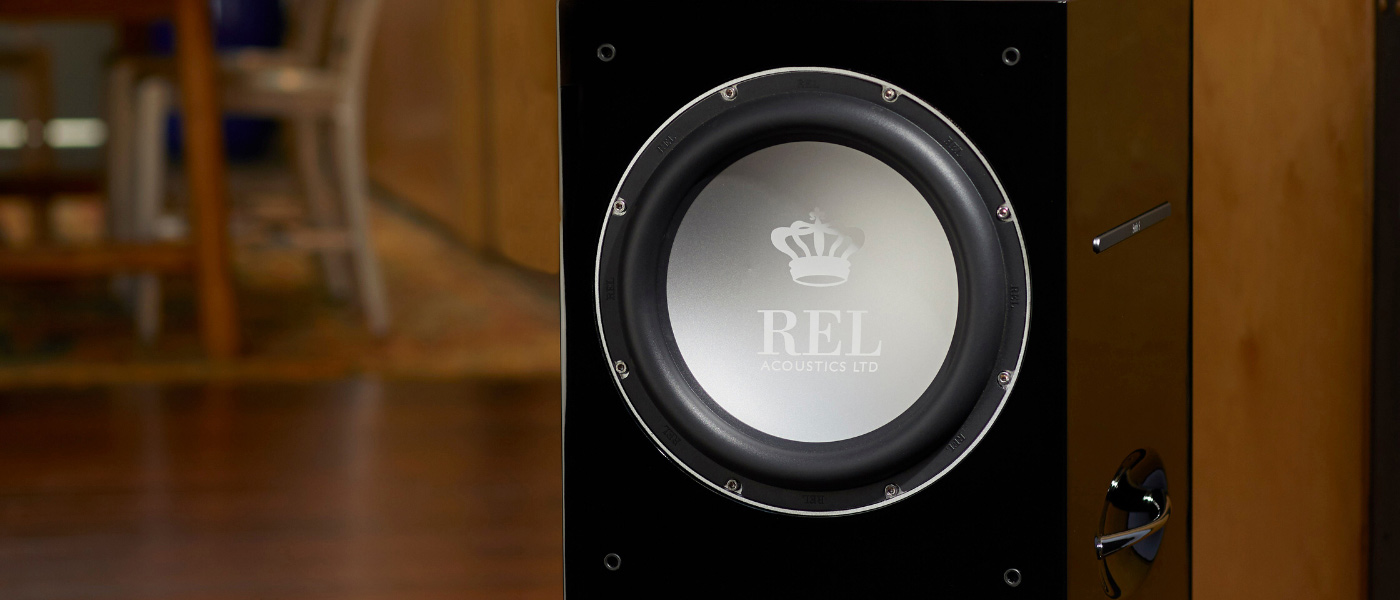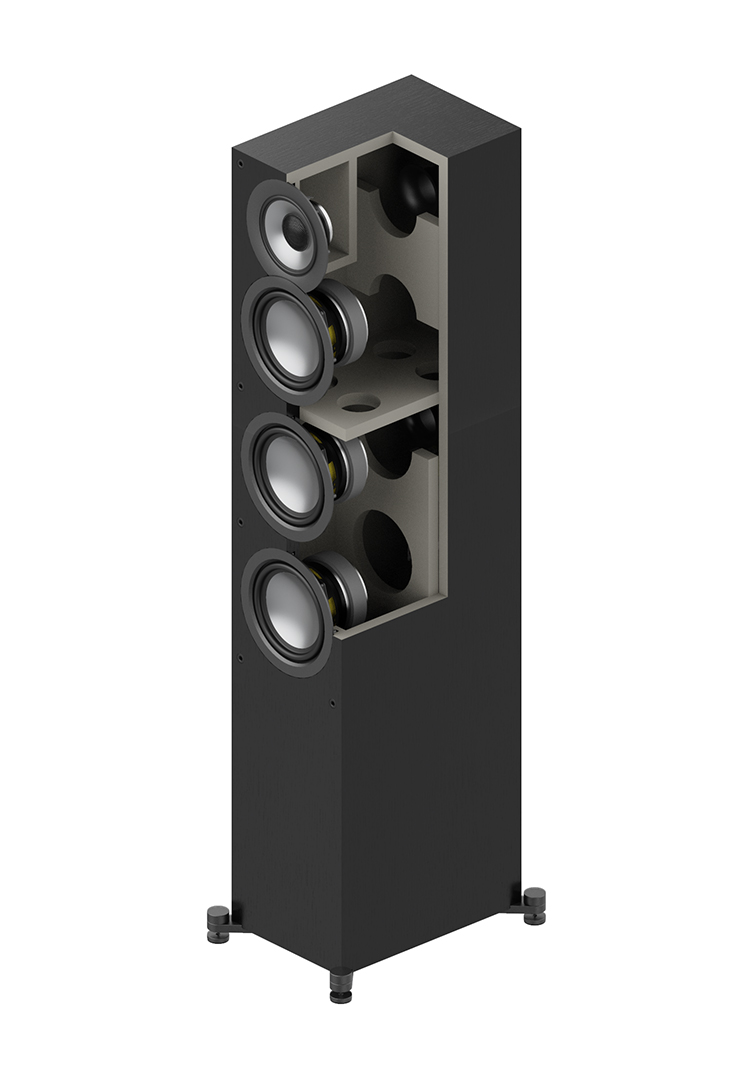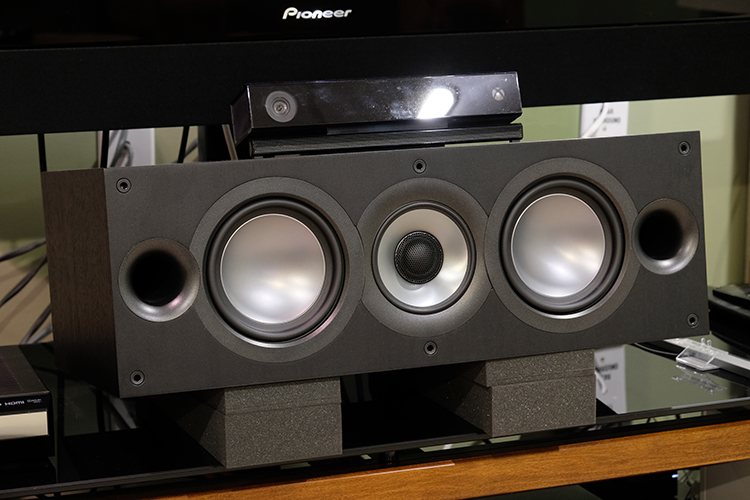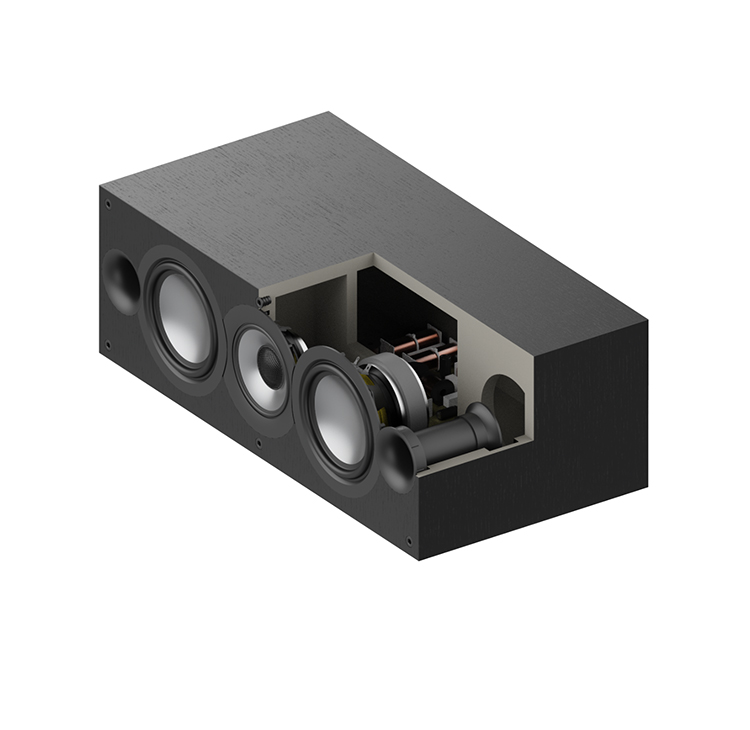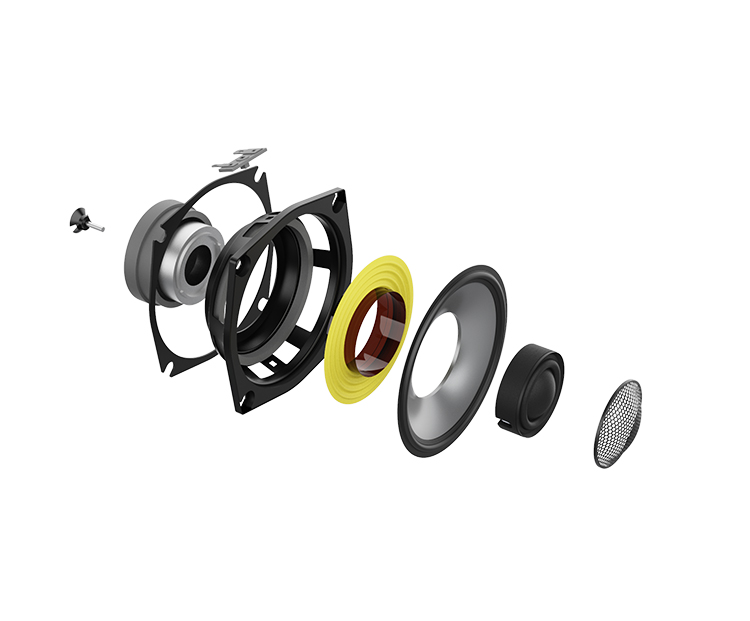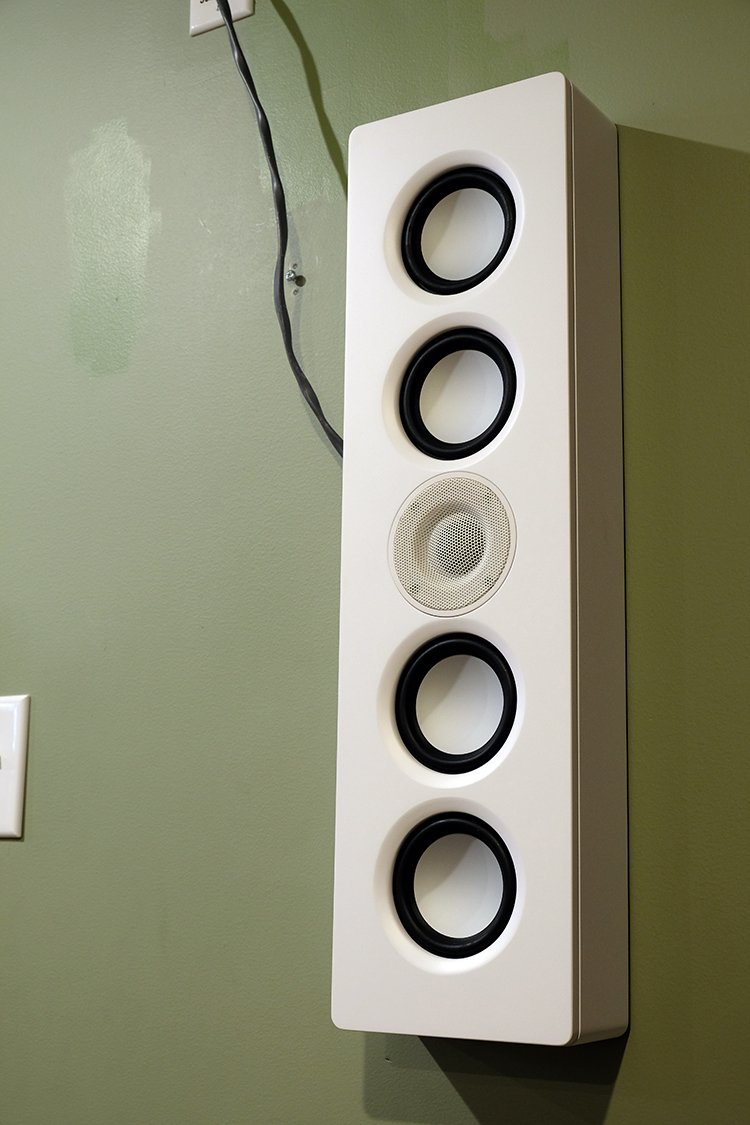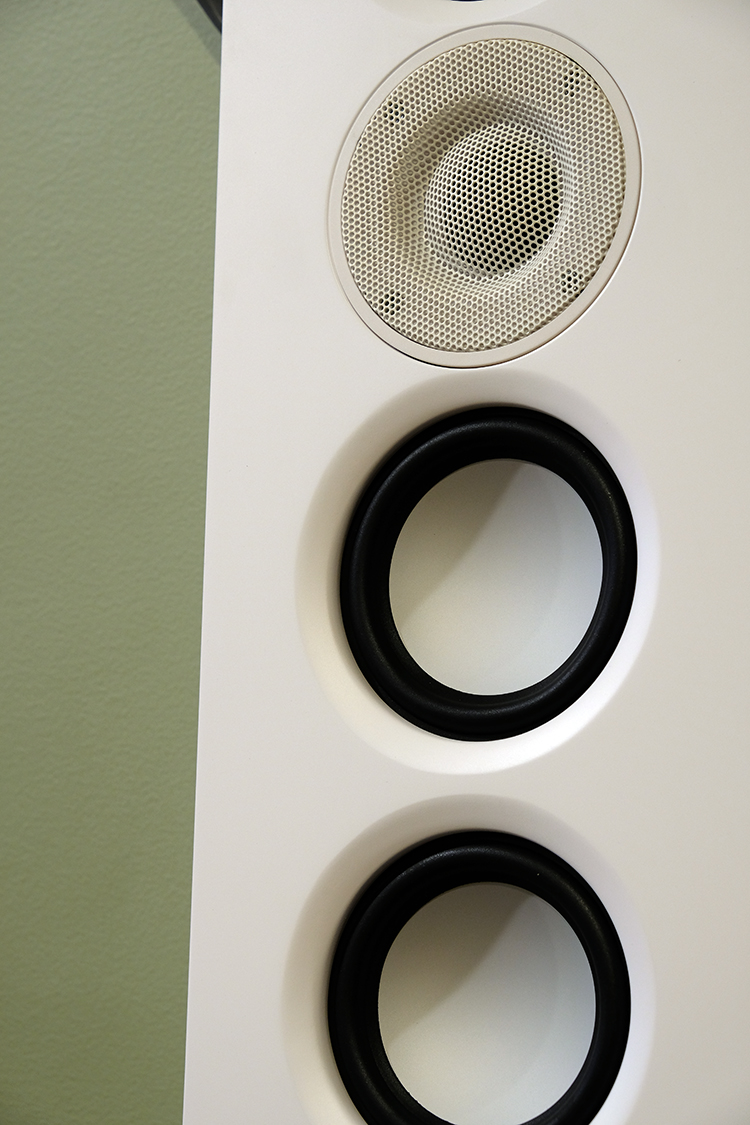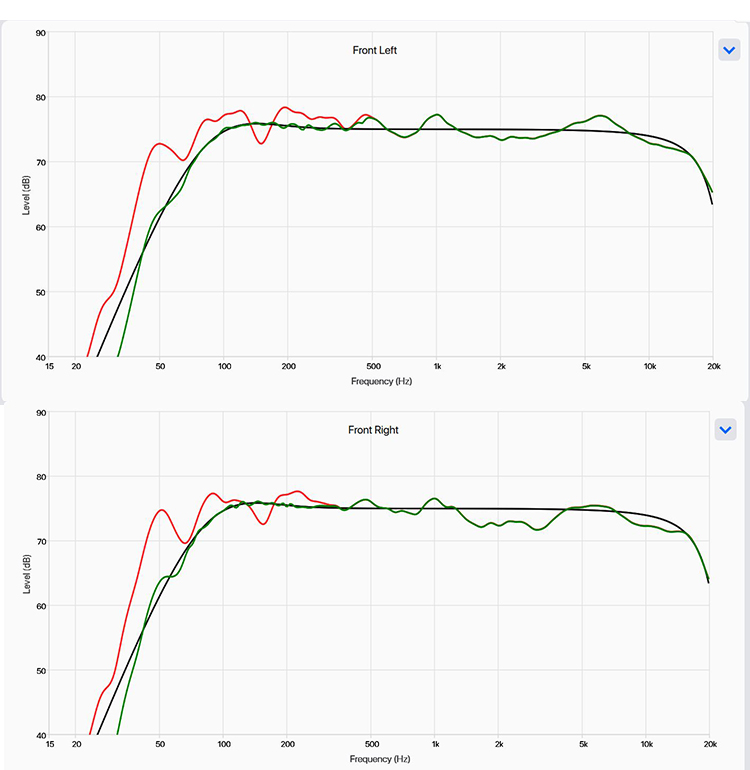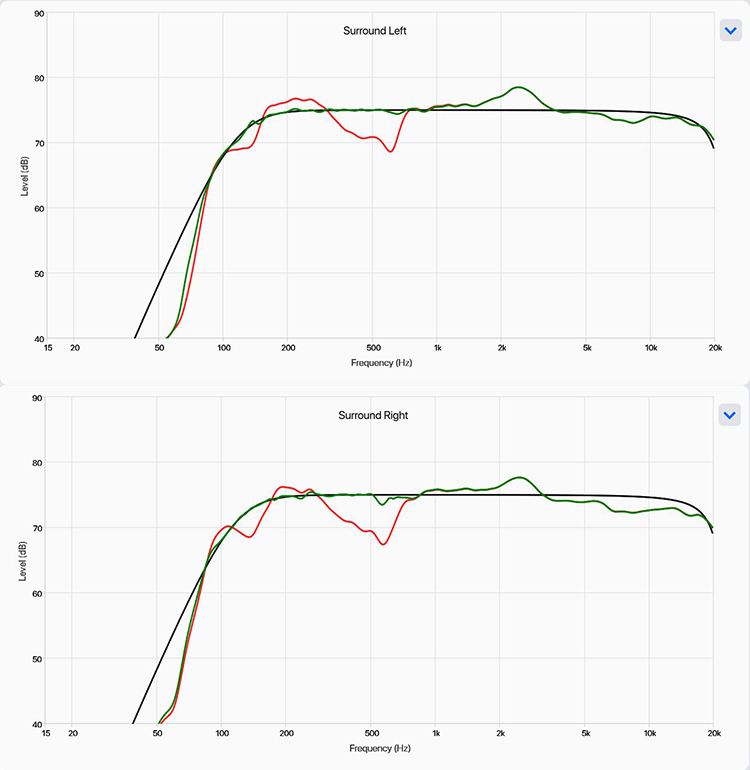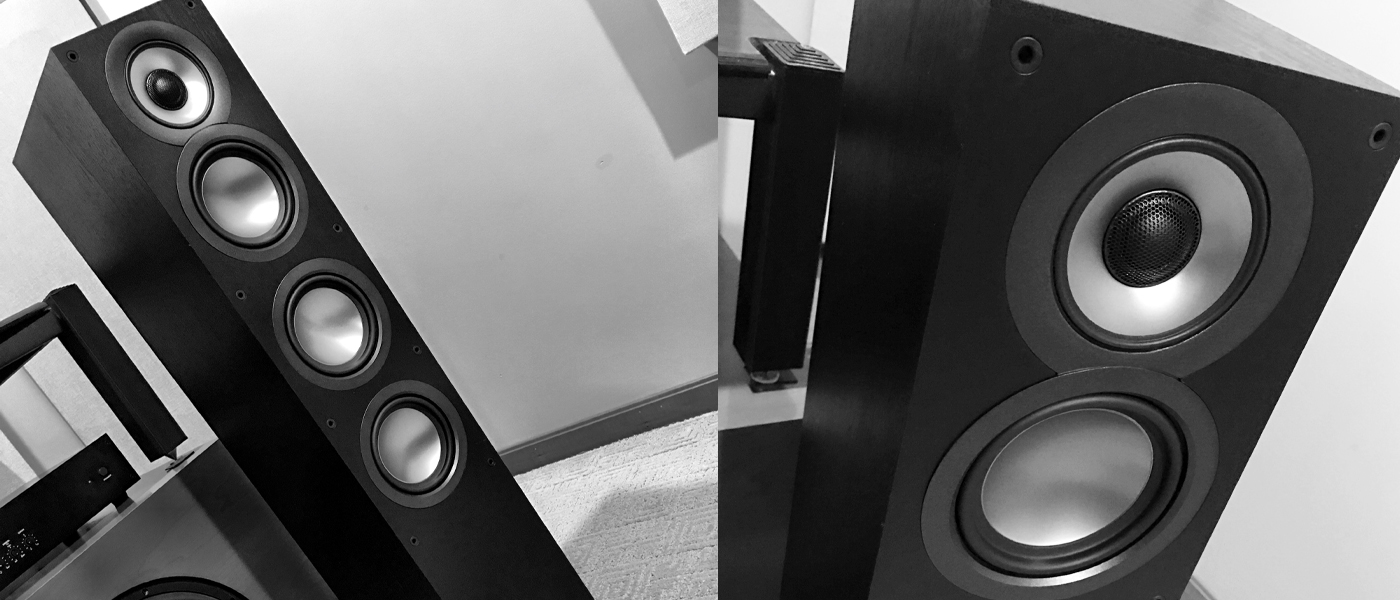
It started with the Debut 2 and then the Debut Reference. Now, it is the Uni-Fi’s turn. Ladies and Gentlemen, introducing the ELAC Uni-Fi 2.0! ELAC provided me with a 5 channel speaker system made up of a pair of Uni-Fi 2.0 UF5.2 towers, a UC5.2 center channel and a pair of MURO OW-V41L on-wall speakers for surround duty. I elected to use my existing subwoofers for the home theater portion of the review.
ELAC Uni-Fi 2.0 Loudspeaker System
- Towers and center channel have an exceedingly wide sweet spot.
- Smooth and coherent sound quality.
- Excellent off-axis performance too.
- Center can be turned on its end and used as an MTM monitor.
- Towers have solid bass punch.
- MURO on-walls are discrete, stylish and sonically mesh well with Uni-Fi 2.0.
- Towers have a slim, stylish footprint.
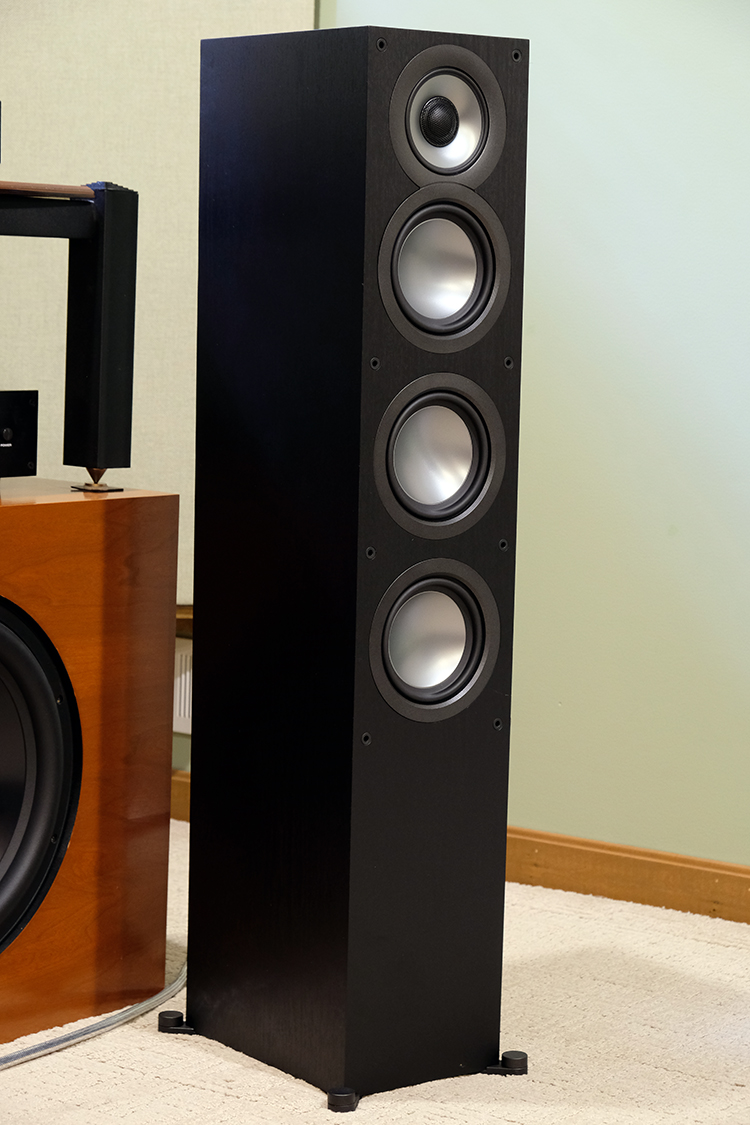
I don’t know when Andrew Jones gets any sleep. Honestly, when ELAC’s jovial VP of Engineering isn’t busy introducing new speakers to unanimous praise, he’s off revisiting and refining his previous designs to wring even better performance out of them. Speaking as an outside observer, he does seem driven to go back and work out any weaknesses that he feels he couldn’t adequately address in the first go around. From conversations that I’ve had with him at shows, when we’ve discussed speakers, it’s clear he keeps track of what compromises needed to be made on a product to hit a given budget, along with what could be improved if he had a few more dollars here and a few extra cents there.
Secrets Sponsor
While he’s already had a second bite at the apple with the recent Debut 2 and Debut Reference speakers, he obviously felt that, three years after it’s launch, it was the Uni-Fi line’s turn for a refreshing, hence the new Uni-Fi 2.0. The product brief is a familiar one to Jones; provide high audio performance in a high value envelope. He did it the first time with the original Uni-Fi. Does the 2.0 set the bar a little bit higher? Let’s press on and see, shall we?
UF5.2 Floor standing Speakers
Design:
3-Way Bass Reflex w/ 3 rear-firing ports
Drivers:
single 1-inch soft dome Tweeter
single 4-inch Aluminum Midrange
three 5.25-inch Aluminum Woofers
Frequency Response:
42 Hz – 35 kHz (manufacturer)
Nominal Impedance:
6 Ohms
Sensitivity:
85 dB @ 2.83v/1m
Crossover Frequencies:
200 Hz, 2 kHz
Maximum Input Power:
140 Watts
Finish:
Black Ash Vinyl w/ Black grilles
Dimensions (WxHxD):
7.28″ x 38.58″ x 10.83″
Weight:
43.34 lbs. (each)
MSRP:
$599.98 (each)
UC5.2 Center Channel Speaker
Design:
3-Way Bass Reflex w/ 2 front-firing ports
Drivers:
single 1-inch soft dome Tweeter
single 4-inch Aluminum Midrange
two 5.25-inch Aluminum Woofers
Frequency Response:
48 Hz – 35 kHz (manufacturer)
Nominal Impedance:
6 Ohms
Sensitivity:
85 dB @ 2.83v/1m
Crossover Frequencies:
200 Hz, 2 kHz
Maximum Input Power:
140 Watts
Finish:
Black Ash Vinyl w/ Black Grilles
Dimensions (WxHxD):
24.42″ x 7.28″ x 10.83″
Weight:
25.74 lbs. (each)
MSRP:
$399.98 (each)
MURO OW-V41L On-Wall Speaker
Design:
2-way, dual passive radiator, sealed
Drivers:
single 1-inch soft dome Tweeter
two 4-inch Aluminum Woofers
two 4-inch Aluminum Passive Radiators
Frequency Response:
75 Hz – 35 kHz (manufacturer)
Nominal Impedance:
8 Ohms
Sensitivity:
86 dB @ 2.83v/1m
Crossover Frequencies:
2.8 kHz
Maximum Input Power:
80 Watts
Finish:
Black Vinyl with Black Grilles or White Vinyl with Grey Grilles
Dimensions (WxHxD):
7.28″ x 25.5″ x 3.35″
Weight:
18.3 lbs. (each)
MSRP:
$449.99 (each)
Website:
Company Directory:
SECRETS Tags:
elac, uni-fi2, concentric, loudspeaker, home theater, speaker reviews, review 2020
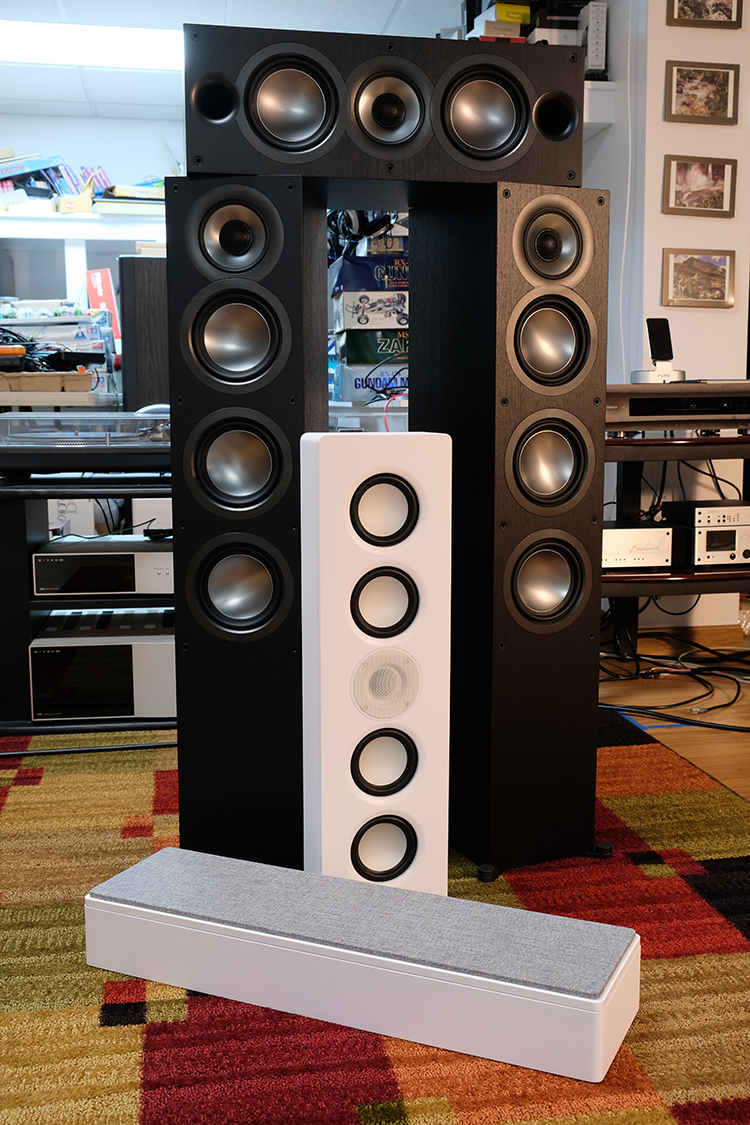
When the original iteration of the Uni-Fi came out, it was available in two distinct versions, Standard and Slim. The Slim, designed to appeal more to European tastes and space requirements, also found much appeal in North America, albeit with a slightly higher price tag. I guess it appealed enough that the Uni-Fi 2.0 is now available only in that slimmer profile. Another visual change is that gone is the contemporary black or white painted finish of the original Slims. All the new Uni-Fi 2.0 speakers come in any color you want, as long as it’s Black Ash vinyl wrap.
The UF5.2 tower speaker is relatively “teensy” for a floor-stander especially when compared to the sister Debut 2. The speakers themselves stand on a pair of included outrigger arms that bolt to the bottom during setup. Four modest adjustable carpet spikes come with each speaker along with a set of four disks with rubber at the bottom to use on hardwood floors. The black ash vinyl-coated cabinet has three tuned ports that are in the back. ELAC claims that they have added additional bracing to the interior of the speaker and knocking on the speaker walls confirms a reassuring feel of solidity.
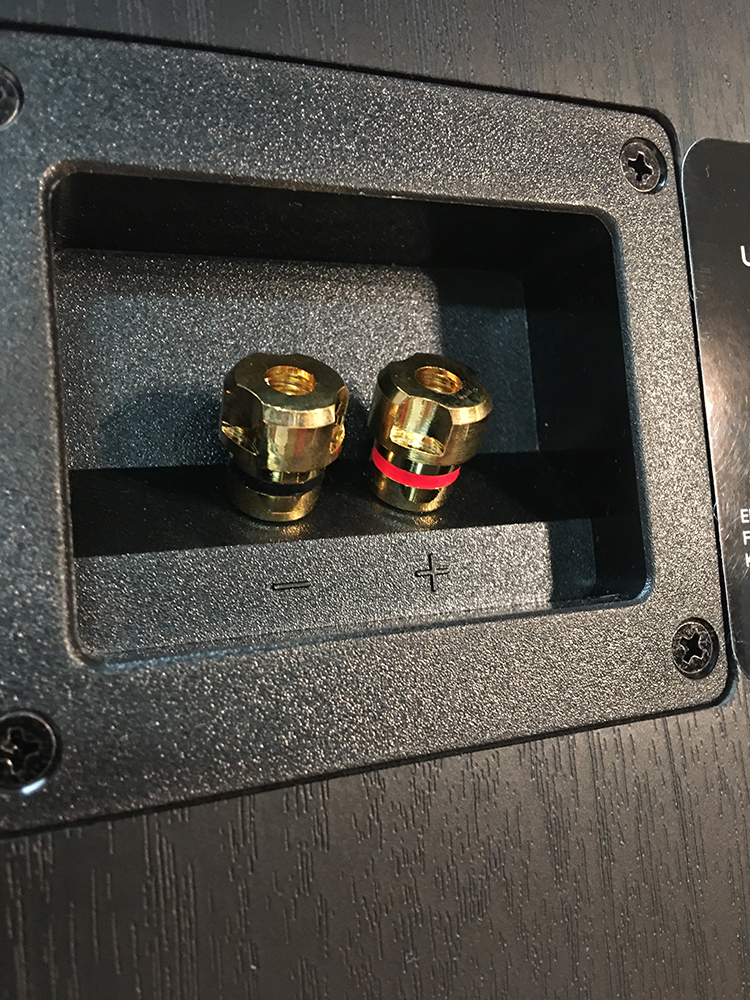
The UC5.2 center channel speaker is similar in size to the previous generation version save with its dual tuned ports located in front this time round. A point some may forget is that, due to the concentric layout of the tweeter and midrange drivers, the center channel speaker can, if desired, be turned on its end and successfully be used as an MTM monitor. One detail that I was slightly dismayed about is the binding posts ELAC chose for the new speakers. The original Uni-Fi Slims had the nicer quality 5-way binding posts that are easier to get a hold of and manipulate. The Uni-Fi 2.0 have ELAC’s standard gold posts that are also seen in the Debut 2 which are a little too close together and are harder to get a grip of. I shouldn’t complain though, because I decided I could live with the simpler finish and binding posts when I eventually saw what the designers DID spend their budget on.
When examining the drivers Jones claims that, based off the work that was done on the higher-end Andante line, the new soft dome tweeter now has a wider operating range (both higher and lower) to ensure flat response to 20 kHz and a smoother transition to the midrange unit. A new wide-roll surround and more powerful magnet structure help keep the tweeter’s linearity and off-axis response more consistent. The midrange cone has been re-profiled, and the aluminum structure enhanced to better manage the blend at the tweeter handoff (the midrange cone doubles as the tweeter’s waveguide). A newly designed, more flexible surround and a re-engineered magnet help extend the mid’s reach down to a lower 200 Hz crossover point. This is a big deal because a mid-woofer crossover point this low (in the room-dominated area of the frequency range) makes it harder to localize the woofers when they come into play, which is a good thing. The tradeoff is typically higher amounts of distortion when you are dealing with a midrange driver this small crossing that low. The new woofer is essentially the same unit as found in the Navis active speakers sporting a one-piece gunmetal colored cone, more flexible surround, and massive magnet structure. Jones claims the new woofers will ensure more impactful sounding bass in all use cases. And finally, the overall impedance has been increased from 4 to 6-Ohms presenting an easier load for an amplifier to drive.
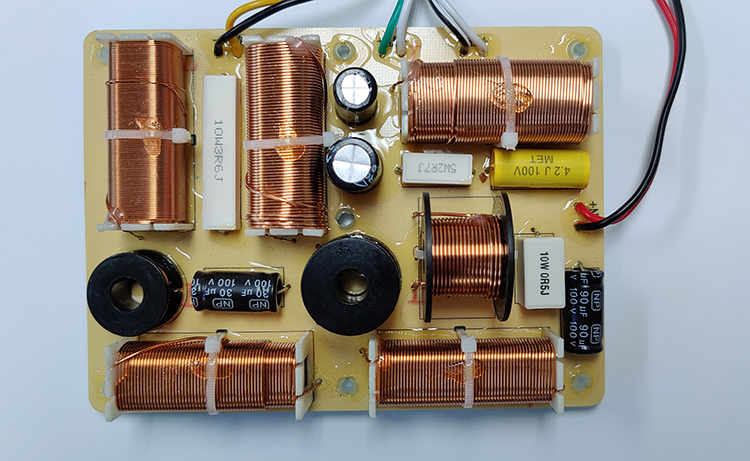
Turning to the crossover, note the number of reactive elements in the Uni-Fi 2.0’s new board – eight inductors and five capacitors. That translates to high order sections used exclusively. To do a crossover at 200 Hz the inductors have to be large, which translates to costly, which is why a “200 Hz high order crossover” and a “$600 tower speaker” are not said in the same sentence. Note that three inductors are air core and one film. The tweeter section likely uses these exclusively which will make a measurable difference from speakers with iron core inductors and electrolytic capacitors.
The large-valued capacitors however have to be electrolytic. A film capacitor does not exist at these values but we would much rather see the high order slopes and low woofer to midrange crossover than tweaky passive components and a 1st order crossover at 600 Hz, or worse a 2.5 way design which is much more common at this price.
As impressive a crossover that this is for the price, putting frequencies 150 Hz and above into a 4-inch midrange is like committing cruelty to small animals. As I alluded to earlier, it will produce significant distortion. It is a trade with a coax design. We want a minimal interaction between the tweeter and midrange cone. The smaller the midrange cone, the better to prevent this and as we will see in the measurement section the coax shows the advantage of the smaller cone. The choice comes down to raising the midrange crossover and making it easy to localize or eating the distortion. ELAC knows the more elegant solution is not to spend more money on the crossover but to punt it and go active, hence the existence of the Navis. Given the driver updates we see here in the Uni-Fi 2.0, the eventual update to the Navis (whenever that happens in the product cycle) should be most intriguing. Maybe they could even incorporate some of the DSP with the nifty dual-pass subwoofer integration that Jay Haider found in his review of the ELAC EA101EQ-G Integrated Amplifier but I digress.
While the Uni-Fi 2.0 has a bookshelf speaker in the line, it does not have an on-wall surround speaker option. Even though I incessantly keep busting Andrew Jones and Chris Walker’s chops about designing a concentric on-wall speaker (sorry guys!). ELAC does however have a compatible line of on-wall speakers called MURO and the pair of OW-V41L on-wall speakers they sent along is a clever and interesting alternative.

At just over 3-inches deep, the MURO intrude minimally into the room as their sealed enclosures hang snug to the wall. If the MURO’s tweeter looks familiar it’s because it’s the same unit found in the Debut 2.0. The tweeter is flanked on either side by a pair of 4-inch woofers and a matching pair of 4-inch passive radiators, driver cone color is matched to the enclosure. The speakers are wrapped in vinyl in your choice of black or white.
The MURO on-wall is capable of being used either vertically or horizontally via the setting of a small toggle switch on the back, just above the binding posts.
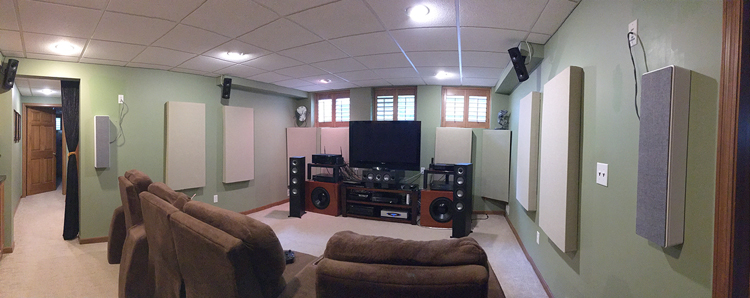
For surround listening, the Uni-Fi 2.0 and MURO speakers were set up in my basement home theater space in my typical 5-channel configuration. The associated equipment included the Anthem MRX 1120 AVR, dual Dayton Reference 15HF subwoofers, OPPO BDP-103 Universal Player, XBOX One, Pioneer 50” KURO Plasma TV, and an APC H15 Power Conditioner. Anthem’s ARC Genesis was used to calibrate the system for home theater listening. Crossovers for the front three channels were set to 80 Hz, the MURO surrounds a little higher at 120 Hz. ARC’s room correction limits were set a maximum of 400 Hz for the left and right channels, 5 kHz for the center channel, and 1 kHz for the MURO surrounds.
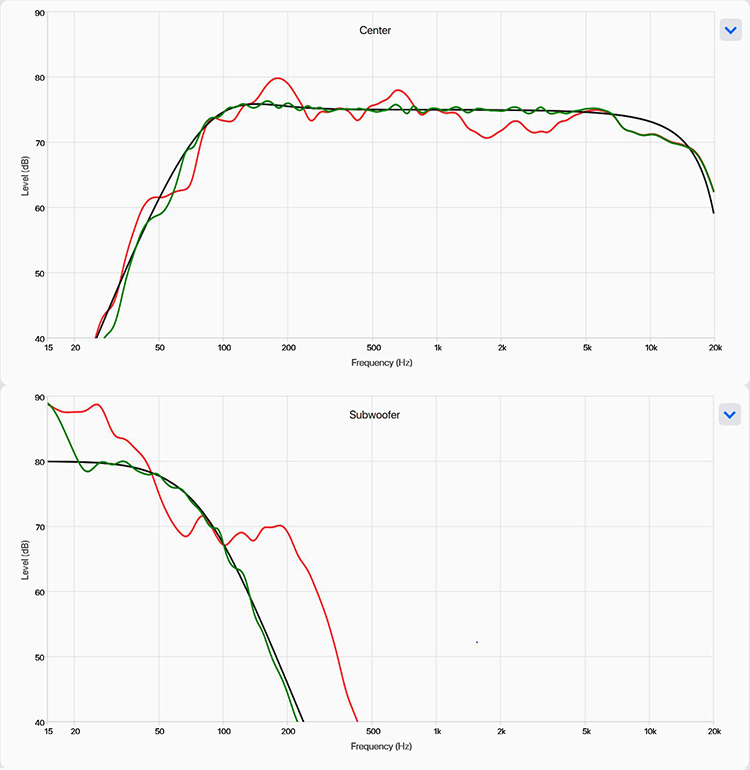
For stereo listening, the Uni-Fi towers were set up in my large studio space and the connected equipment included the Benchmark Media HPA4 preamp, the AHB2 power amplifier, DAC 3B D/A converter, the Anthem STR preamp and STR power amplifier, ELAC Discovery music server, and a KAB modified Technics SL1200 MK 6 with Audio-Technica OC9ML/II MC cartridge.
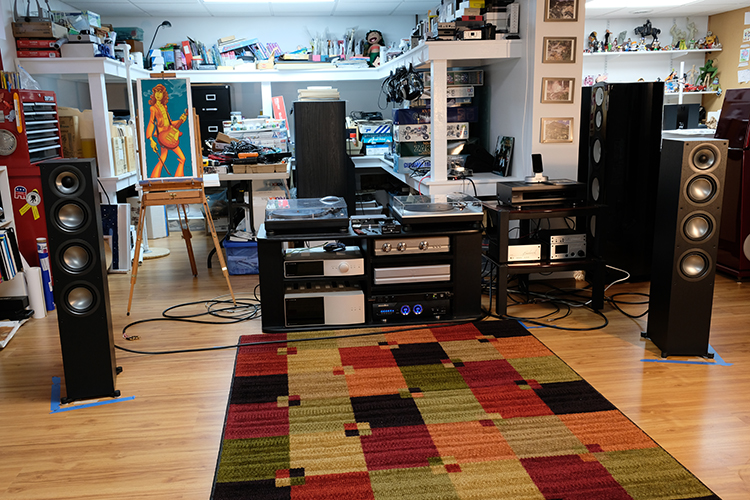
In both my home theater and stereo listening I found that the UF5.2 towers required less toe-in than I would typically use for a non-concentric driver loudspeaker.
I’ve conducted a few reviews of ELAC speakers in my time at Secrets, and a review of the TAD CE-1 that Andrew Jones was involved with, so I have a fairly clear idea of what to expect when I am auditioning one of his designs. By and large they tend to exhibit what I call an “alive” quality in-room. By this I mean that the sound compliments vocals and the midrange region along with having a gently recessed lower treble region that returns and then smoothly and gradually declines as it continues up, and finally a punchy but not subterranean level of bass. The TAD’s were a wonderful and supremely refined version of that same concept save for having an extended bass response.
Up until now the Navis active speakers (I have not had a chance to spend quality time with the more upmarket Andantes) have been, to me, the most impressive sounding of Jones’ ELAC designs that I have reviewed. To my ears, the Uni-Fi 2.0 surpasses the sound of Navis in many respects. Keeping in mind that the Navis active speakers that I reviewed were the bookshelves and the Uni-Fi 2.0 are towers, so I know they should have more bass capacity in my larger room. The UF5.2 Towers were impressive to listen to in stereo, less for their bass response which I expected to sound good (and it did), but because this iteration of ELAC’s concentric driver has brought this speaker’s performance to another level, and it shows. ELAC’s concentric driver speakers have always had a notably wide soundstage and good off-axis performance while sounding nicely detailed and clear on-axis. The UF5.2 towers (and by extension the UC5.2 center) have even better off-axis performance now, making them great speakers to listen to casually. When listening critically in the typical sweet spot, the overall imaging is cleaner and sharper and the added portrayal of depth, in several instances became almost holographic, more so than what the Navis and original Uni-Fi were able to achieve in the same rooms. That “cleaner” sounding impression is something I tried to focus in on during my listening sessions. Whenever I would put on a good vocal track or I would focus on a saxophone or strings in a solo (for example), I really noticed how transparent and free of effort the performances sounded. The improvement was apparent when I swapped back and forth between the new speakers and the old Uni-Fi especially, and even a little bit when compared with the Navis.
Secrets Sponsor
These observations translate even more starkly in the home theater environment. The original Uni-Fi sounded very good in my home theater but being 4-ohm speakers made pushing their volume a challenge for some AV receivers I had around. Having an external multi-channel amplifier with some extra power on tap made a big difference with the previous generation Uni-Fis. The 2.0 are a much easier load and getting good clean volume out of them was not an issue. As a side note, I could easily see someone make an effective surround system with five UC5.2 center speakers with the mains and surrounds channels turned on their ends. Add a sub or two and you’d have a perfectly matched system. The MURO on-walls also did yeoman’s work as surround speakers in my theater. Sonically they were close enough of a match to the Uni-Fi 2.0 that the blend was extremely consistent. Whether for music or movies, the MURO on-walls imaged surround effects precisely and with a sufficiently wide spread.
Not to sound overly simplistic in this summation, but there are speakers that sound bad, speakers that sound good and there are also speakers whose sound is addictive. The Uni-Fi 2.0 speakers fall into that latter category for me. I found myself actively searching for different music and movies outside of my usual standbys to try out on them because they sounded so enticing to listen to.
If I had to nitpick about anything, it would be that I would be willing to pay a few extra bucks for a different finish (like a walnut or cherry) and bringing the better binding posts back.

Junior Brown, Down Home Chrome, Telarc, Multi-channel SACD, 2004.
This well recorded multi-channel album allowed the Uni-Fi 2.0 and MURO combination to demonstrate some superb imaging. The UC5.2 center channel handles Junior Brown’s deep, resonant vocals with proper tone and depth especially on the track “It Hurts when I do that”. On “Little Rivi-Air Head” Brown’s guitar fills emerge from each channel at various points and the MURO surrounds keep up nicely with similar timbre and blend to the front Uni-Fi 2.0.
His distinctive guitar sounds the same in each and every channel. The track “Jimmy Jones” has Brown’s spoken narration coming squarely out of the center channel and it sounds eerily alive and tangible in room with the surrounds filling out the ambience effectively. “Let’s Go Back” features a duet with Junior and his wife (and rhythm guitar player) Tanya Rae Brown. It also provides for an interesting test of the front three channels of a surround system because I have had different speakers image the two singers either practically on top of each other in the center, or too far apart, or even in some cases floating above the center speaker, closer to the ceiling! The Uni-Fi 2.0 ensemble properly and specifically places the vocals of JB and TR in the proper left & right space on either side of the center speaker so as mimic two singers onstage together. The result was quite striking. “Monkey Wrench Blues” just made me feel like I was listening to Junior Brown in the small local theater that I saw him perform live a few years ago. Very effective audio illusion!

Al Di Meola, Flesh on Flesh, Telarc, Multi-channel SACD, 2002.
This is another one of Telarc’s excellent surround recordings from another guitar master. “Zona Desperata” creates an excellent sense of immersion via the Uni-Fi 2.0 and MURO system. The concentric drivers do a great job of getting the different tones, details, and characters of the various guitars Di Meola uses in the deeply layered composition. The MURO surrounds with their smaller drivers seem to keep up with the bigger Uni-Fi’s without issue.
Pans that sweep around from side and front to back are seamless and tonally match. Drum cymbals sound so crisp and metallic! “Fugata” has congas and maracas in the surrounds with guitar and a gorgeous sounding flute dueling in the center. Again, the MURO on-walls seem to do an excellent job of tonally matching with the mains here. The flute solo had tremendous detail to its sound. I know I’ve mentioned that there is bound to be some distortion penalty to be paid when crossing the midrange driver at 200 Hz, but in no time during any of my listening did that become noticeable from a subjective standpoint.
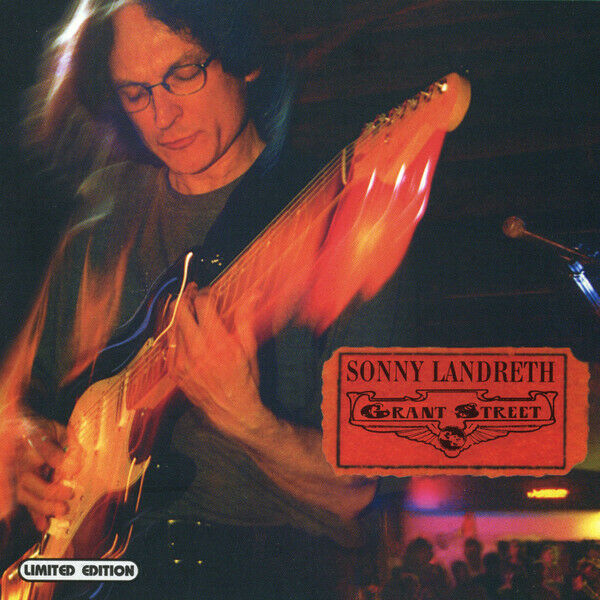
Sonny Landreth, Grant Street, Sugar Hill Records, 2005, 16/44 FLAC.
This is a great stereo live recording inside the Grant Street dance hall in Louisiana. I like to use this album to test the imaging and soundstage of a set of stereo speakers because the right pair will take this recording and project a deep and almost holographic image of the environment. There are a number of speakers I’ve had here that do this well but only a handful can create an illusion so good that it’s almost palpable. The Uni-Fi 2.0 UF5.2 towers are squarely on that list.
On the song “Broken Hearted Road” the song opens up with a slow deep heartbeat of a bassline which sounds tight and punchy. The interior of the bar was just imaged so thoroughly and completely around me that I was doing multiple double-takes at the sounds of tinkling bar glasses, beer bottles and general audience banter. It sounded so spookily real and encompassing. Then Sonny and the band kick in and just the sound of his voice and then his slide guitar playing along with the ambience of the venue made for a superb listening experience. Completely immersive with just two speakers!

Spider-Man Into the Spider-Verse, Sony Pictures, 2019 Blu-Ray.
I am a traditionalist, therefore I am typically loathe to re-imaginings and alternative takes on characters that I have a deep attachment to. Disney’s incessant live action gold-digging of their classic animated movies, for example, drives me into conniptions! That being said, this take on Spider-Man and the whole wretched overused “Multi-verse” trope actually works, and it works extremely well. Visually, the whole graphic style of the film is masterfully done; the entire film has the appearance of a living, breathing print comic book whose look spans Marvel’s multiple production ages.
Sonically, the audio is as surprising and as all-encompassing as the visuals. The ELAC Uni-Fi 2.0 and MURO combination took full advantage of the incredible Dolby ATMOS audio and engulfed me in the often frenetic, New York soundscape. Audio pans in every direction were seamless. The scenes where Miles Morales is just discovering and coming to grips with his newfound powers are really well done. The audio cues, effects, voices are coming from every direction and they all sound clean and perfectly placed around me. The UC5.2 center channel is an absolute champ! It resolves vocals, music, and effects as well as the towers do and is as seamless a match as I’ve heard in speakers of this price range.
Measurements by Carlo Lo Raso, Technical Analysis by Carlo Lo Raso and David A. Rich
Bench tests were performed with a Cross Spectrum Labs calibrated UMIK-1 USB microphone connected my Surface 3 PRO tablet and using Room EQ Wizard acoustic measurement software. On and off-axis measurements were taken with the mic at a distance of 1-meter from the center point of the tweeter. Unlike measurements taken outdoors or in an anechoic chamber that measure a speaker in isolation (and assess straight-line engineering), in-room measurements give a sense of how a speaker behaves in the actual environment that it’s used. Both types of measurements are valuable, I just find in-room measurements interesting as they help shed light on what I am hearing and why. That and I don’t own an anechoic chamber!
Impedance measurements were taken using the Dayton Audio DATS v3 loudspeaker tester and software. This is the first time we are showing off our new toy. You may have seen “do it yourself” impedance testing with a resistor in line with one side of the speaker wire connected to a little sound card ADC. That gets you the current flowing in the speaker. You measure the voltage across the speaker at the same time. You must keep the voltage small lest the sound card gets fried. For $129.00 you get a nifty hardware box that does the whole thing fully protected, coupled with neat software, that gets you lots of measurements speaker designers need in addition to this impedance graph. At the moment, it does not allow scaling the phase angle which is why its plot is crushed up.
Many discussions can be found on the internet that go into great detail about impedance measurements. This article from Archimago’s Musings is a good place to start.
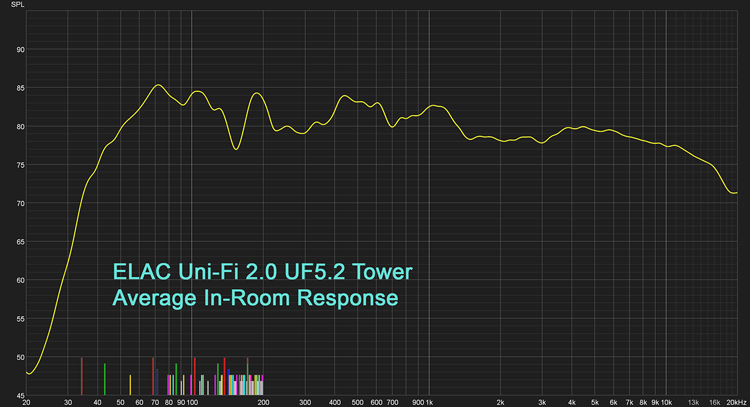
This in-room measurement of the ELAC UF5.2 towers is an 18-point spatial average. A 9-point measurement was made for the right speaker and then repeated for the left speaker. Averaging both speakers is an approach that others have been using and publishing. Using data from both speakers reduces the modal response of the room by averaging the differences in the response of the two speakers from room asymmetries. The technique cannot eliminate them however and, as such, the response below 300 Hz remains room dominated. The results show a fairly consistent response from 400 Hz on up, exhibiting a mild trough between 200 Hz – 400 Hz and a small dip centered at about 750 Hz. These seem to be consistent room interaction areas with a variety of speakers that I’ve tested in this room. Some speaker responses react more severely than others in these areas and the UF5.2 Towers seem fairly tolerant here compared to some others. The dip at 160 Hz is a floor bounce (the distance from the woofer to the floor and back to the speaker) which appears in all my speaker measurements in this room. This particular bounce dip is not as severe as others that I’ve measured. Bass response seems to drop off below 50 Hz in this room. The peak at 70 Hz may correlate to the sense of impact, as opposed to outright bass depth found in the listening impressions. Treble response shows a smooth and gentle decline to 15 kHz with a more pronounced decline thereafter. A mild “BBC dip”, a gentle drop in the presence region allowing the midrange more notice, occurs between 1.5 and 3.5 kHz. If this was not a coax design we might think this is energy loss from non- coincident drivers and not a designer’s voicing. We will see that the dip does not go away in the quasi-anechoic radiation pattern curves below.
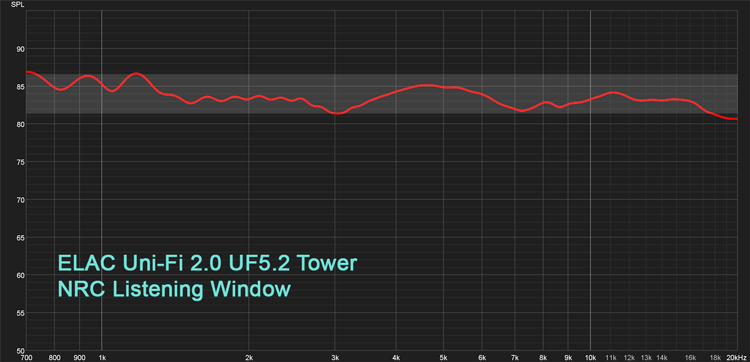
This is a plot of the NRC listening window for the ELAC UF5.2 towers, scaled from 700 Hz on up which is averaged from the following measurements: 0-degree on-axis, +/- 15 vertical, +/- 15 horizontal. The 700 Hz limit in this curve is the result of the gated window we used to remove room reflections. With floor standers we cannot move them off the floor. What we are really interested in is the response below the crossover to the tweeter itself and that we have captured. Ignore the little crossover voicing thing and you see a very smooth curve. No signs of tweeter resonance or issues that would point to problems with the coax driver. This is 1/12 octave smoothing so we are not covering this up with whip cream. Note those little oscillations below 1.2 kHz are most likely reflections that we could not gate out of the measurements.
The curve fits in a +/-2.5dB window, but that spec alone doesn’t tell the whole story. A speaker response that bounces around in that window will not automatically sound good, it needs to be smooth and well controlled too. Note how smooth this curve is without obvious driver resonance or, for a coax, added interference issues between the tweeter and midrange cone.

Above are the horizontal radiation curves of the ELAC UF5.2 towers from 0 to 30 degrees, scaled from 700 Hz on up. On-axis there is a strange little dip at 7 kHz but it goes away as we come off-axis. Since the NRC Listening Window average uses only +/- 15 degrees it picked up more of this dip than it would if we made an average using wider angles.
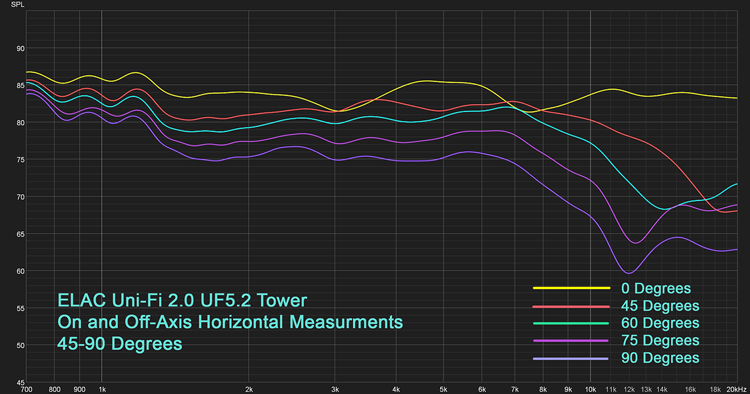
Above are the horizontal radiation curves from 45 to 90 degrees, scaled from 700 Hz on up. Cheap coax drivers exhibit all sorts of problems in this test but none of them are here at 1/6th octave smoothing. No interference effects to be seen. The off-axis plots are very smooth with the expected monotonic tilt. Note they are smoother than the on axis. No snap back at all above the tweeter crossover. Plain-Jane finish aside, this is a very nicely designed speaker full stop.
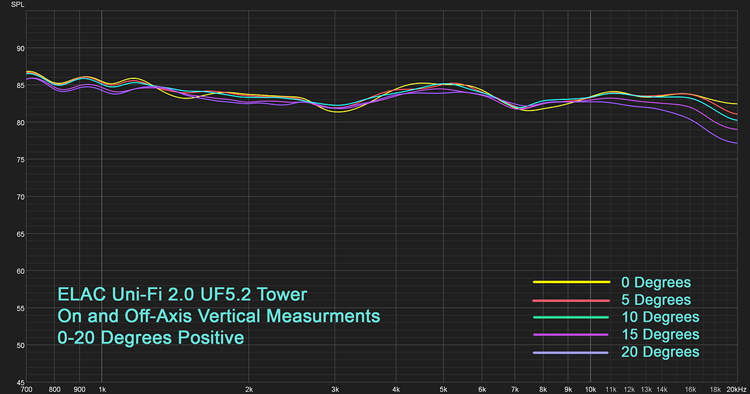
Moving to the vertical radiation pattern for positive angles, we see the plots for 0 to +20 degrees, scaled from 700 Hz on up. These show a tight, consistent grouping with very little change which is possible only with a good coax design. Again, there are no signs of resonance; just the little 7 kHz depression which is not significant. This speaker should sound very much the same whether you are standing up or sitting down.
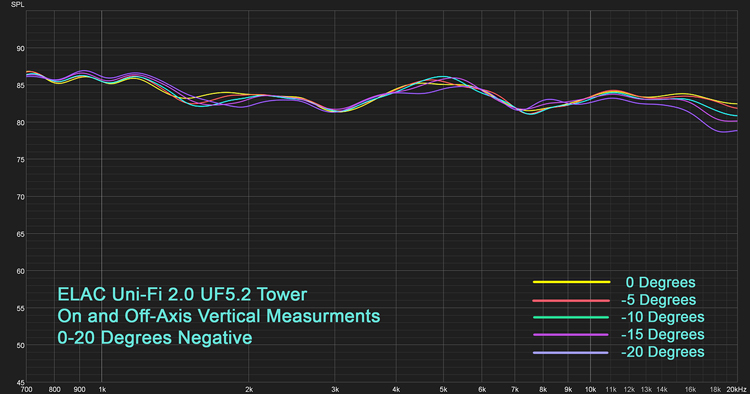
In the vertical radiation pattern for negative angles, we see the plots for 0 to -20 degrees, scaled from 700 Hz on up. The response is almost identical to the positive verticals. That little dip at 1.5kHz off-axis is not worth worrying about. With non-coincident drivers you would be looking at a cancelation dip larger than 10 dB. The peak at 7 kHz is likely diffraction and is, again, not significant.
Taken as a whole, the listening window and radiation pattern graphs do not look at all what one expects at this price range. That great looking coax, at this price, happens partially since it is only 4-inches. Crossing such a small speaker over at 200 Hz gets you these excellent quasi-anechoic results but costs in significantly more distortion from 150 Hz – 300 Hz than a speaker with a 5.25-inch midrange and a separated tweeter. Of course, finding such a true 3-way with a 200 Hz crossover is likely to cost far more than this.
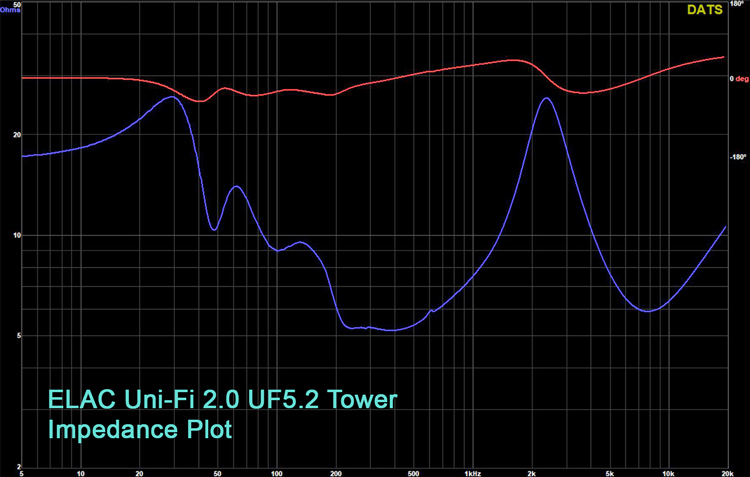
Here is the impedance plot for the ELAC UF5.2 towers (blue trace) showing that it remains at or well above a 6-Ohm impedance for much of its range save for a drop to 5.2-Ohms between 200 – 600 Hz. This should pose no problem for almost any amplifier. You note two peaks at the low end. This indicates the speaker is ported. Which peak is higher has to do with how the port resonance frequency of the complete speaker was chosen relative to the free air resonance of the driver. Anechoic distortion measurements tell you if the designer got the design of the port correct not this curve. The peak at 2 kHz is the crossover between midrange and tweeter.

This is an in-room measurement of the ELAC UC5.2 center channel speaker. The results show a fairly consistent response from 600 Hz on up. There is a little bit of a midrange hump between 400 – 600 Hz along with a short dip at 220 Hz. Bass response seems to drop off below 50 Hz in this room. Treble response looks good but with a light bump between 4 – 7 kHz. The speaker is near the floor, so we are getting this lift in the lower midrange as this is really all about speaker placement. As we will see in the near fields, the speaker is remarkably similar to the tower except for the bottom end. It is missing a woofer and the box is smaller. If you want to hear how good this center speaker is, get it off the floor and flip it 90 degrees.
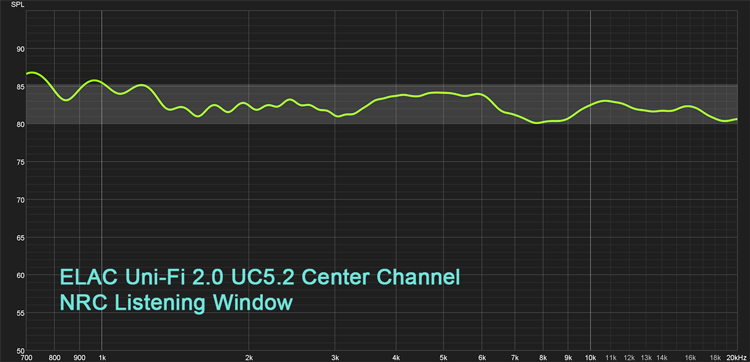
This is a plot of the NRC listening window for the ELAC UC5.2 center channel, scaled from 700 Hz on up which is averaged from the following measurements: 0-degree on-axis, +-15 vertical, +-15 horizontal. Here we see a nicely controlled and uniform response in the portion of the frequency range that is dominated by the speaker (response below 300 Hz tends to be dominated by the room and can vary greatly). We must point out how close this is to the tower speaker’s listening window measurement. This is the coax driver in action coupled with the very low 200 Hz crossover to the woofer.
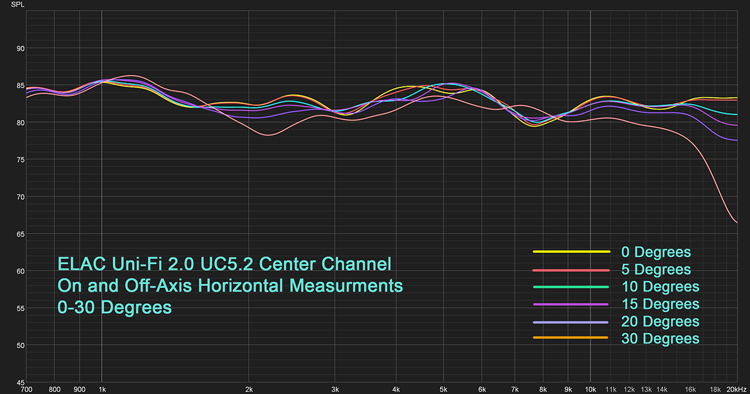
Above are the horizontal radiation curves of the ELAC UC5.2 center channel from 0 to 30 degrees, scaled from 700 Hz on up. Here we see more activity in the 4 kHz – 7 kHz range than in the tower. This is likely due to the wide baffle the coax is seeing with the side by side woofers.

Above are the horizontal radiation curves from 45 to 90 degrees, scaled from 700 Hz on up. Again, more activity around 4 kHz – 7 kHz than the tower, but compared to a typical center channel with a 600 Hz crossover and side mounted woofers, this would not even be worth commenting on. Instead, the huge suck outs and reinforcement of a 600 Hz woofer pair to – midrange crossover would be the center of attraction in the curve. For an MTM center speaker, with no midrange, we would be crossed at 2.5 kHz to the woofers and this could be so messy it would be clear that listening outside the center seat would result in dramatic tonal changes. A center channel producing this curve, at this price, is an excellent performer, period.
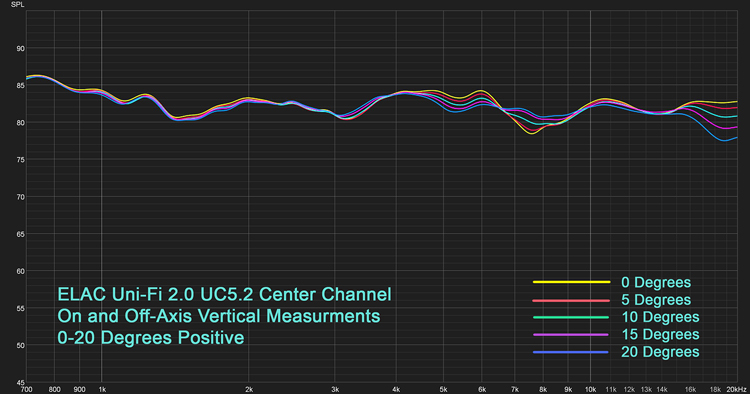
Moving to the vertical radiation pattern for positive angles, we see the plots for 0 to +20 degrees, scaled from 700 Hz on up. These show a tight, consistent grouping with very little change. Again, this speaker should sound very much the same whether you are standing up or sitting down. If you compare this to the tower, these curves are remarkably close. They have to be to get that matching NRC window to the tower we saw above. Only a tad more change in the 4 kHz – 7 kHz range than the tower, but a whole other world from a comparable speaker with the midrange and tweeter offset.

In the vertical radiation pattern for negative angles, we see the plots for 0 to -20 degrees, scaled from 700 Hz on up. The response is almost identical to the positive verticals; again, very well controlled. The radiation patterns of the center scream for it to be flipped 90-degrees and used as an LCR or with the tweeters at the same level the towers on L and R. Put the TV on the floor and give the speaker some respect.

Here is the impedance plot for the ELAC UC5.2 center channel (blue trace) showing that it remains at or well above a 6-Ohm impedance for much of its range save for a drop to 5.2-Ohms between 200 – 600 Hz. Very much like the towers.
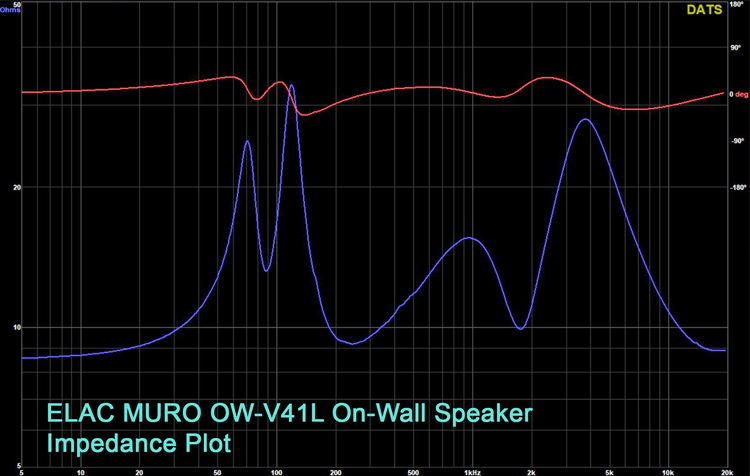
Here is the impedance plot for the MURO OW-V41L on-wall speaker (blue trace) showing that it remains at or well above an 8-Ohm impedance for the entirety of its operating range.
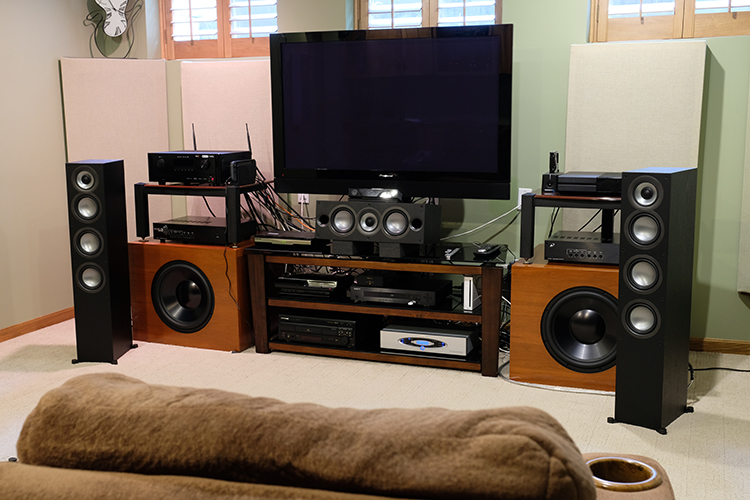
The Uni-Fi 2.0 is one of the easiest recommendations I can give for an affordable and superb sounding line of speakers. Highly recommended!
- Big soundstage and superb clarity.
- Towers have a small footprint.
- Center seamlessly matches the towers.
- MURO on-walls sonically work well and make viable surround speakers.
- Other finishes.
- Better binding posts.
- Would pay a small premium for the above two requests.
The ELAC Uni-Fi 2.0 is a notably significant audio upgrade over their predecessors. In fact, for the money, I’d say there are precious few speakers that achieve the level of performance and enjoyment that the Uni-Fi 2.0 are capable of, either in stereo or surround. I found them to be able to generate a huge and at times holographic image that made them instantly likable and addictive to listen to. Yet they also had plenty of detail and clarity in their presentation that made me feel like I wasn’t wanting for anything from either vocals or instruments. A quality 3-way loudspeaker in this price bracket is rare. ELAC had already shown that they can produce an affordable 3-way using the concentric driver, now they’ve showed that they can refine the design for even better performance. When used in a home theater, the UF5.2 towers and the UC5.2 center channel make for a seamless and frankly killer front end. The MURO on-wall was a nice little surprise as well. Its use as a discrete on-wall speaker solution was never a question. That it could work as a matching and effective surround solution with the Uni-Fi 2.0 in my room was happy circumstance. It’s flexible and gives people looking to set up a full surround system some options, which is always a good thing. I would consider the Uni-Fi 2.0 and MURO loudspeakers an absolute best buy. My colleague David Rich puts it even more directly, “When your music loving, non-audiophile friend asks for a speaker recommendation, the ELAC Uni-Fi 2.0 UF5.2 towers are the speakers to steer them to. Tell them to spend no more and live with those basic black cabinets.”
The author wishes to thank David A. Rich for his assistance in this review.


